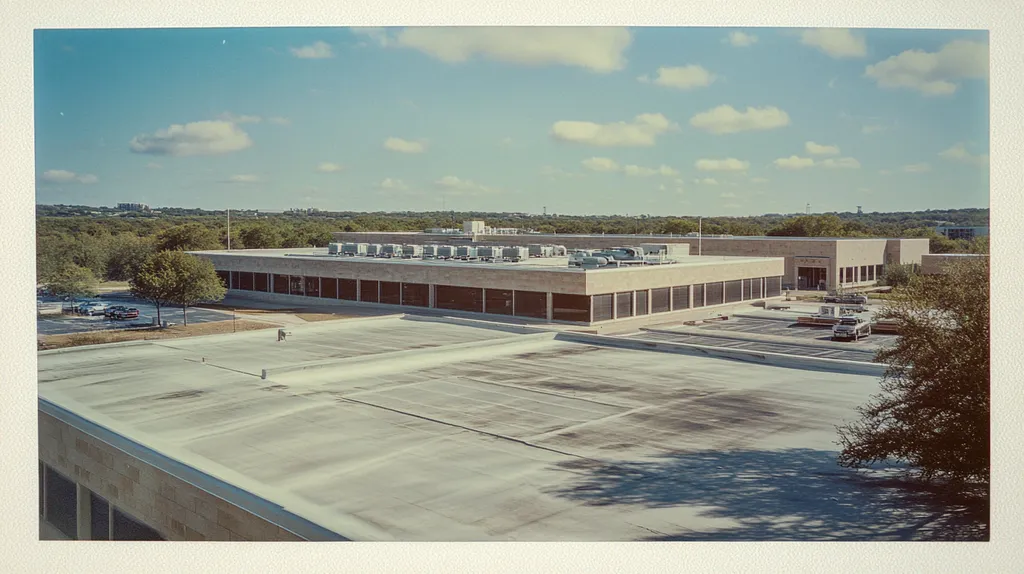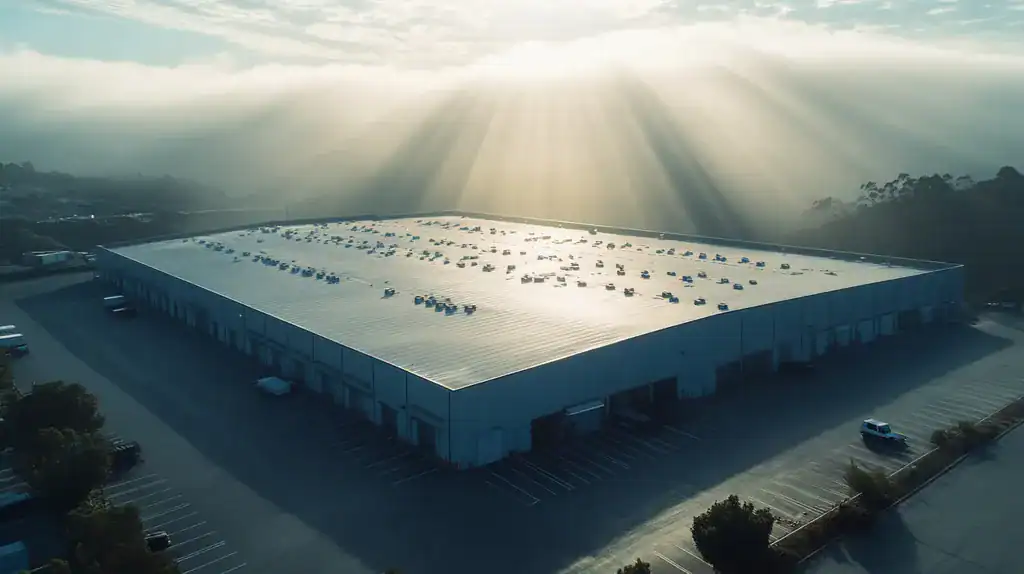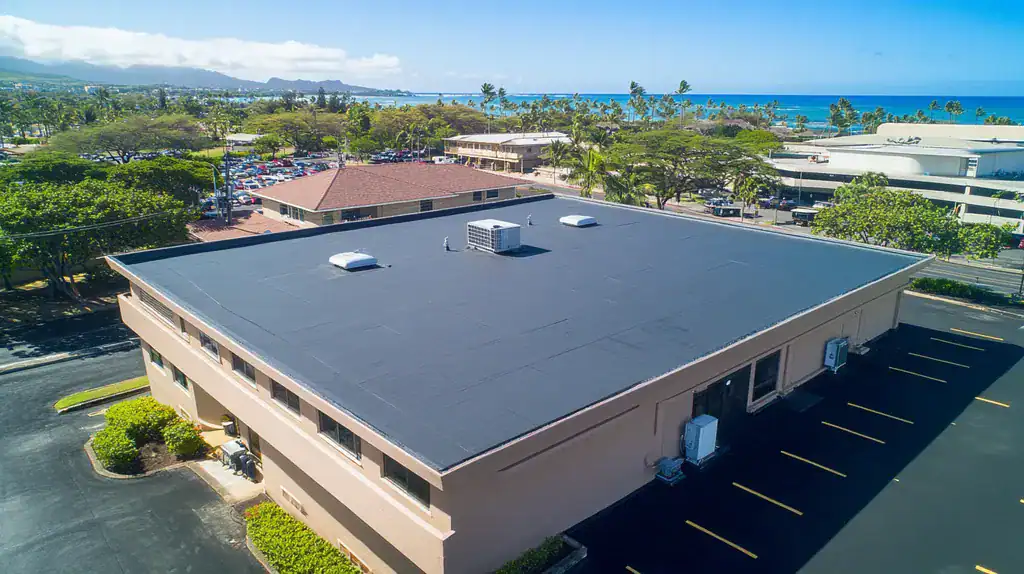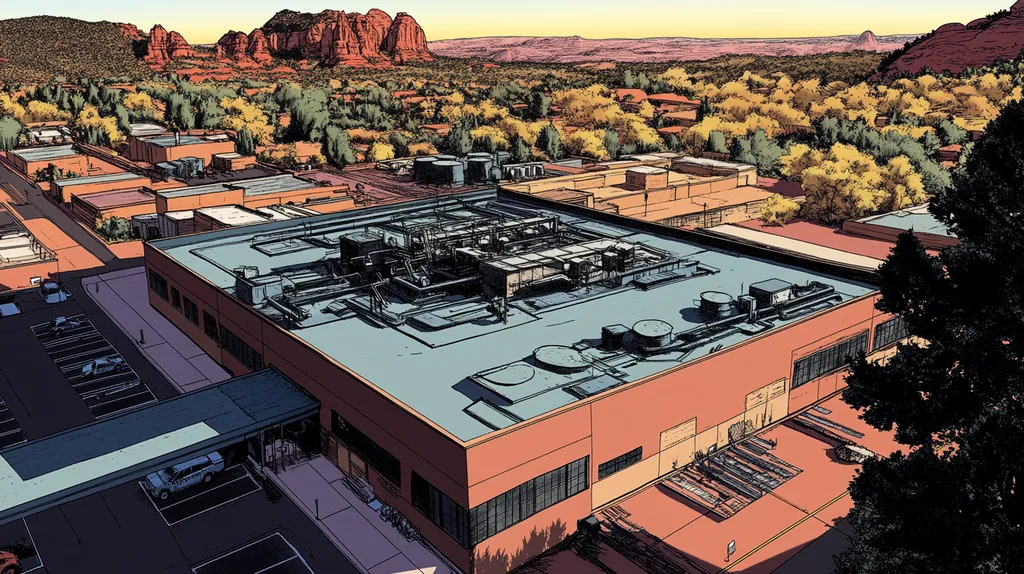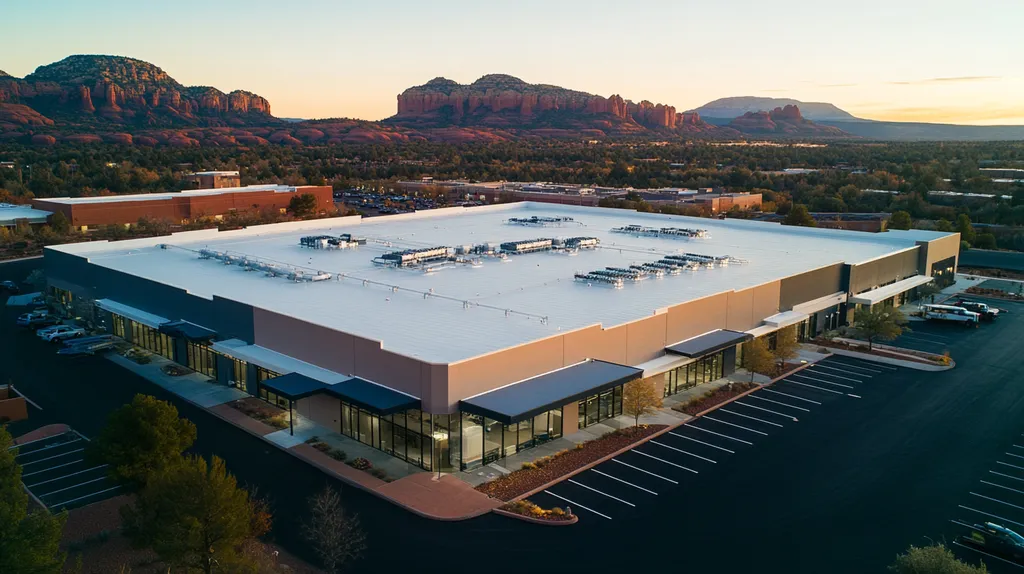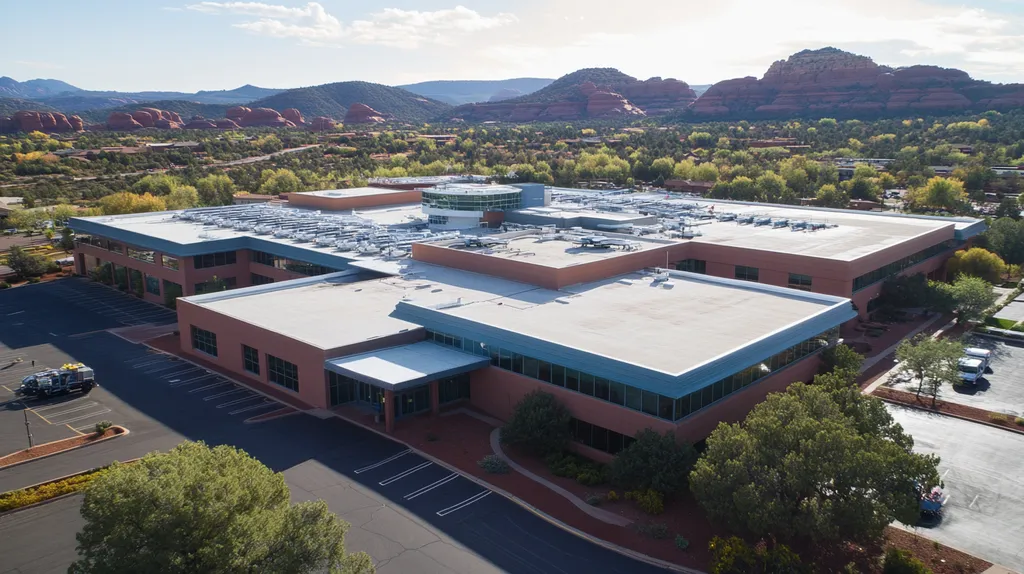As energy costs continue to soar, commercial building owners face a critical challenge: up to 40% of their total energy consumption goes to cooling costs alone.
Unprotected roofs are a major culprit, absorbing and transferring massive amounts of solar heat into buildings while driving up utility bills and accelerating roof deterioration.
Modern roof coating systems offer a powerful solution, capable of reducing roof surface temperatures by up to 50°F while slashing cooling costs by 20-30% annually.
This comprehensive guide examines how these specialized coatings work, when to use them, and how to maximize their energy-saving potential for your commercial property.
SECTION 1: THE BASICS EXPLAINED
Commercial building owners face an urgent challenge as energy costs continue to surge. Studies show that cooling costs can represent up to 40% of a building’s total energy consumption, with unprotected roofs being a major contributor. The solution lies in advanced roof coatings that can dramatically reduce heat absorption and energy waste, transforming your roof from a liability into an asset.
What It Is (In Plain Language)
Roof coatings are engineered layers that act like a thermal shield for your building. Think of them as a sophisticated sunblock that reflects heat and UV rays away from your roof’s surface.
These protective layers come in several formulations, with aluminum-based coatings being particularly effective at minimizing heat absorption and reducing the workload on air conditioning systems. (source: Karnak Corporation)
Modern coating systems typically consist of a base layer for adhesion and durability, followed by a top layer engineered for maximum reflectivity. This dual-layer approach ensures both protection and performance.
The coating creates a seamless membrane that not only reflects heat but also protects against water infiltration and UV damage, extending your roof’s lifespan while reducing energy costs.
Why It Matters (To Your Building)
The financial impact of an uncoated roof is substantial. During peak summer months, traditional dark roofs can reach temperatures exceeding 150°F, forcing cooling systems to work harder and consume more energy.
Energy-efficient coatings can reduce roof surface temperatures by up to 50°F, resulting in immediate and significant reductions in cooling costs. This temperature reduction directly impacts your bottom line through lower utility bills.
Beyond immediate cost savings, coated roofs contribute to building sustainability goals and can help achieve LEED certification points. This enhanced environmental performance can increase property value and attract quality tenants.
The return on investment typically occurs within 3-5 years through energy savings alone, not counting the extended roof life and reduced maintenance costs.
How It Works
Energy-efficient coatings function through three primary mechanisms: reflection, emissivity, and insulation. The coating’s surface reflects solar radiation away from the building, preventing heat absorption at the source.
High emissivity allows any absorbed heat to quickly release back into the atmosphere rather than transferring into the building. This dual action maintains lower roof temperatures even during peak sunshine hours.
The coating’s seamless membrane also eliminates thermal bridges – areas where heat can easily transfer through the roof structure. This creates a more consistent thermal barrier across the entire roof surface.
Modern coatings maintain their reflective properties for years, though performance can gradually decrease due to weathering and dirt accumulation. Regular maintenance can help maintain optimal energy efficiency throughout the coating’s lifetime.
SECTION 2: PRACTICAL APPLICATIONS
Commercial roofing decisions directly impact both immediate operations and long-term facility costs. Recent industry data shows that unprotected roofs can increase cooling costs by up to 35% compared to properly coated surfaces. Understanding where, when, and how to apply roofing coatings has become crucial for facility managers looking to optimize their building’s performance and reduce operational expenses.
Common Uses & Examples
Reflective coatings serve as the cornerstone of modern commercial roof efficiency. These specialized materials create a highly reflective surface that dramatically reduces heat absorption, particularly on large flat or low-slope roofs common in warehouses and retail centers.
Elastomeric coatings provide essential protection for roofs subject to thermal cycling and structural movement. These flexible materials maintain their protective properties even as the building expands and contracts throughout temperature changes.
Waterproof coating systems excel in high-precipitation regions, creating an impermeable barrier that prevents moisture infiltration. These coatings are particularly valuable for manufacturing facilities where equipment protection is paramount.
Facilities maintenance through proper coating application produces substantial savings by decreasing equipment replacement costs and reducing renovation expenses through enhanced system efficiency. (source: U.S. National Center for Education Statistics)
When You Need It Most
Climate conditions often dictate optimal coating timing. Buildings in regions with intense solar exposure benefit most from application during spring months, allowing proper curing before peak summer temperatures.
Urban heat island effects make coatings particularly crucial for buildings in densely developed areas. These locations typically experience temperatures 5-7 degrees higher than surrounding regions, making heat reflection especially valuable.
Aging roofs approaching their warranty limits present prime opportunities for coating application. A properly timed coating system can extend roof life by 10-15 years while improving energy performance.
Buildings undergoing energy efficiency upgrades should prioritize roof coatings as part of their improvement strategy. This integration maximizes the return on investment across all energy-saving initiatives.
Interactions With Other Systems
Roof coatings work synergistically with existing insulation systems. The combination of reflective surfaces and proper insulation creates a more effective thermal barrier than either component alone.
HVAC efficiency improves significantly when paired with reflective coatings. Reduced heat load means air conditioning systems operate more efficiently and require less maintenance over time.
Modern coating systems complement solar panel installations by maintaining lower roof temperatures. This temperature reduction helps photovoltaic systems operate at peak efficiency.
Building automation systems can better regulate indoor environments when working with coated roofs. The more stable thermal conditions allow for more precise climate control and reduced energy consumption.
SECTION 3: KEY TERMINOLOGY DECODED
The technical language of commercial roofing often creates costly confusion for property owners. Studies show that misunderstanding key roofing terms leads to poor coating choices that waste up to 40% of potential energy savings. Clear comprehension of essential terminology enables better decision-making and maximizes the return on roofing investments.
Essential Terms Explained
Solar reflectance measures a coating’s ability to bounce sunlight away from the roof surface. The higher the reflectance value, the less heat enters your building, directly impacting cooling costs.
Thermal emittance describes how effectively a roof releases absorbed heat back into the atmosphere. High-emittance coatings prevent heat buildup by quickly dissipating thermal energy rather than allowing it to transfer into the building.
Solar Reflectance Index (SRI) combines both reflectance and emittance into a single value. This unified measurement helps compare different coating options, with higher SRI values indicating better overall thermal performance.
Aluminum-based coatings create highly reflective surfaces that dramatically reduce heat absorption while decreasing air conditioning system workload. These specialized formulations provide exceptional protection against UV radiation and thermal stress. (source: Karnak Corporation)
Industry Jargon Translated
Cool roof systems refer to any roofing solution engineered to maintain lower surface temperatures. These systems typically combine reflective coatings with proper insulation to maximize energy efficiency.
Substrate compatibility indicates whether a coating will properly adhere to your existing roof material. Proper compatibility ensures long-term performance and prevents premature coating failure.
Mil thickness measures coating depth in thousandths of an inch. Proper mil thickness ensures adequate protection while avoiding excess material waste.
Dry film thickness (DFT) represents the final coating thickness after curing. Understanding DFT requirements helps ensure proper application and maximum coating effectiveness.
Measurement & Units Simplified
Reflectance values range from 0 to 1, with higher numbers indicating better heat reflection. A reflectance of 0.70 means the coating reflects 70% of solar radiation away from your roof.
Energy savings are typically measured in kilowatt-hours (kWh) reduced per square foot of roof area. This measurement allows for direct comparison of different coating options’ efficiency impact.
Surface temperature reduction is measured in degrees Fahrenheit or Celsius. Quality coatings can reduce roof surface temperatures by 50-60°F during peak summer conditions.
Warranty periods for coatings typically range from 10-20 years. Longer warranties often correlate with higher-quality materials and better long-term performance.
SECTION 4: DECISION FACTORS
Making informed decisions about roof coatings has become increasingly critical as energy costs continue to climb. Research shows that poor coating choices can negate up to 60% of potential energy savings while leaving buildings vulnerable to accelerated degradation. Property owners must carefully weigh multiple factors to maximize their return on investment and achieve optimal energy efficiency.
Cost Considerations
Initial coating costs typically range from $2-8 per square foot, varying significantly based on material quality and application complexity. However, focusing solely on upfront expenses often leads to costly mistakes in long-term performance.
Premium coatings generally deliver superior returns through reduced energy consumption and extended roof life. High-performance products can reduce cooling costs by 20-30% annually while lasting up to twice as long as budget alternatives.
Labor costs represent 40-60% of total project expenses. Professional installation by qualified contractors helps ensure proper coverage and adhesion, maximizing the coating’s energy-saving potential.
Many utility companies offer rebates for energy-efficient roof coatings, potentially offsetting 15-25% of project costs. Tax incentives and depreciation benefits can further improve the financial equation.
Performance Trade-offs
Sustainable roof coatings deliver multiple benefits beyond simple weatherproofing, including dramatic reductions in energy usage and enhanced indoor comfort. These improvements translate directly into operational cost savings while extending roof system durability. (source: Specguard Coating Systems)
Climate conditions significantly impact coating performance. Hot, sunny regions benefit most from high-reflectivity products, while areas with frequent precipitation require superior waterproofing properties.
Application thickness affects both protection level and material costs. Thicker coatings provide better waterproofing but require more material, while thinner applications may need more frequent recoating.
Surface preparation requirements vary by coating type and existing roof condition. Proper preparation is essential for adhesion but adds to project complexity and cost.
Lifespan & Durability Factors
Expected service life varies dramatically between coating types, ranging from 5-20 years under normal conditions. Premium products typically offer longer warranties and better resistance to environmental stresses.
UV exposure represents the primary degradation factor for most coatings. High-quality products maintain their reflective properties longer, preserving energy efficiency benefits throughout their service life.
Regular maintenance can extend coating lifespan by 25-40%. Simple measures like periodic cleaning and prompt repair of minor damage help maintain energy-saving performance.
Substrate compatibility directly impacts long-term durability. Mismatched materials can lead to premature failure and lost energy efficiency, regardless of coating quality.
SECTION 5: COMMON CHALLENGES
Energy-efficient roof coatings represent a significant investment that can fail without proper attention to common pitfalls. Industry data shows that up to 30% of coating applications underperform due to preventable issues, leading to wasted energy costs and premature system failure. Understanding and addressing these challenges head-on can mean the difference between optimal performance and costly disappointment.
Frequent Problems & Solutions
Poor surface preparation remains the leading cause of coating failure. Contaminants, moisture, and uneven surfaces prevent proper adhesion, leading to blistering and delamination that compromise energy efficiency.
Weather conditions during application can make or break coating performance. Temperature extremes, high humidity, and unexpected precipitation can prevent proper curing and reduce long-term effectiveness.
Inadequate coverage creates weak spots in the protective barrier. Insufficient mil thickness or uneven application leaves some areas vulnerable to accelerated weathering and heat absorption.
Reflective coatings can significantly reduce cooling loads while protecting roofs from environmental damage, but only when properly applied. These specialized materials require precise installation techniques to achieve their full energy-saving potential. (source: Tillotson Enterprises)
Warning Signs To Watch For
Surface discoloration often signals degrading reflective properties. Areas that appear darker or duller than surrounding sections indicate compromised energy efficiency that requires immediate attention.
Ponding water after rainfall suggests drainage issues that can accelerate coating breakdown. Even high-quality coatings will fail prematurely if water regularly collects on the roof surface.
Visible seams or separation at edges point to movement-related stress. These weak points allow heat infiltration and moisture penetration that undermine the coating’s protective properties.
Bubbles or blisters in the coating surface indicate trapped moisture or air pockets. Left unaddressed, these defects expand and create entry points for both heat and water.
Preventative Approaches
Regular inspections form the foundation of effective coating maintenance. Quarterly visual assessments can identify emerging issues before they compromise energy performance.
Professional cleaning maintains reflective properties and extends coating life. Scheduled cleaning removes dirt and pollutants that can degrade the coating’s ability to reflect heat.
Proper drainage management prevents premature coating failure. Keeping drains clear and addressing low spots eliminates standing water that accelerates deterioration.
Documentation of all maintenance activities creates valuable historical data. This information helps identify patterns and optimize the timing of recoating or repair work.
Strategic repair protocols address small issues before they expand. Having an established process for handling minor damage prevents energy-wasting weak spots from developing.
SECTION 6: NEXT STEPS & RESOURCES
The decision to implement energy-efficient roof coatings represents a critical turning point for commercial properties. Studies show that buildings without optimized coating systems waste up to 30% more energy on cooling costs annually. With energy prices continuing to rise, facility managers must take decisive action to protect their buildings and budgets through informed coating choices.
Questions To Ask Providers
Begin by requesting detailed energy performance data for proposed coating systems, including projected ROI calculations and expected cooling cost reductions. Generic claims without supporting metrics should raise immediate concerns.
Verify the provider’s experience with your specific roof type and their documented success rates. Ask for case studies of similar buildings where their coatings have delivered measurable energy savings.
Examine their quality control protocols, including surface preparation standards and application monitoring procedures. These factors directly impact coating performance and longevity.
Request a comprehensive maintenance plan that outlines inspection schedules, cleaning requirements, and repair protocols. Clear guidance helps maintain optimal energy efficiency throughout the coating’s lifespan.
Industry Standards & Guidelines
Commercial roof coatings can dramatically improve building energy efficiency through enhanced solar reflection and reduced heat absorption. Proper application ensures these systems deliver maximum performance while extending roof life. (source: Cole Roofing)
Key standards include ASTM D6083 for acrylic coatings and ASTM D6694 for silicone formulations. These guidelines establish minimum performance requirements for durability and weather resistance.
Energy Star certification requirements provide essential benchmarks for coating reflectivity and emissivity. Meeting these standards often qualifies projects for utility incentives and tax benefits.
Local building codes may mandate specific performance criteria, particularly in urban heat island zones. Early verification of these requirements prevents compliance issues.
Further Learning Simplified
The Roof Coatings Manufacturers Association (RCMA) offers comprehensive technical bulletins explaining coating selection and application best practices. These resources help facility managers make informed decisions.
Professional certification programs through organizations like NRCA provide structured learning paths. These courses cover energy efficiency optimization and system maintenance.
Industry trade shows showcase emerging coating technologies and application methods. These events offer valuable opportunities to evaluate multiple solutions simultaneously.
Regional energy efficiency organizations frequently conduct workshops on building envelope improvements. These sessions often include specific guidance for local climate conditions.
The Bottom Line
With commercial buildings wasting up to 40% of their cooling costs through inefficient roofs, the need for proper coating systems has never been more urgent.
Modern roof coatings deliver documented energy savings of 20-30% while extending roof life by 10-15 years, creating a compelling business case for implementation.
The technology exists today to transform every commercial roof from an energy liability into a high-performance asset that reduces operating costs and supports sustainability goals.
Property owners who delay coating decisions face increasing exposure to rising energy costs, accelerated roof deterioration, and diminished building value.
The path forward is clear: energy-efficient roof coatings represent a proven solution for protecting both buildings and budgets in an era of climbing operational costs.
FREQUENTLY ASKED QUESTIONS
Q. What is a commercial roof coating?
A. A commercial roof coating is a protective layer designed to reduce heat absorption, enhancing energy efficiency. These coatings help your roof reflect sunlight, significantly decreasing cooling costs and extending the roof’s lifespan.
Q. When should I apply coatings to my industrial roof?
A. The best time to apply coatings is during the spring when there’s less risk of extreme temperatures. This timing allows the coatings to cure properly before summer heat peaks, ensuring maximum effectiveness in reducing temperatures and energy costs.
Q. What does solar reflectance mean for my commercial roof?
A. Solar reflectance measures how well a coating can bounce sunlight away from the roof. A higher solar reflectance value translates to less heat entering your building, significantly reducing the demand on air conditioning systems and lowering energy bills.
Q. How can I ensure a successful coating application on my commercial roof?
A. To ensure a successful application, invest in professional installation, ensuring proper surface preparation and adherence to standards. Regular inspections and maintenance can also prolong the life of the coating and enhance its performance over time.
Q. What common challenges affect commercial roof coatings?
A. Common challenges include poor surface preparation, inappropriate weather conditions during application, and inadequate coverage. Addressing these issues upfront can prevent performance failures and costly damage to the roof system.
Q. What resources can I use for more information on coatings for commercial roofs?
A. Consider exploring resources like the Roof Coatings Manufacturers Association for technical bulletins and guidelines, or attend industry trade shows to learn about advancements. Engaging with professional organizations also offers educational opportunities for facility managers.
Q. How does regular maintenance impact my industrial roof coating’s effectiveness?
A. Regular maintenance, including inspections and cleaning, enhances the coating’s reflective properties and overall lifespan. Proactively managing minor issues helps maintain energy efficiency and prevents costly degradation of the roof system over time.

